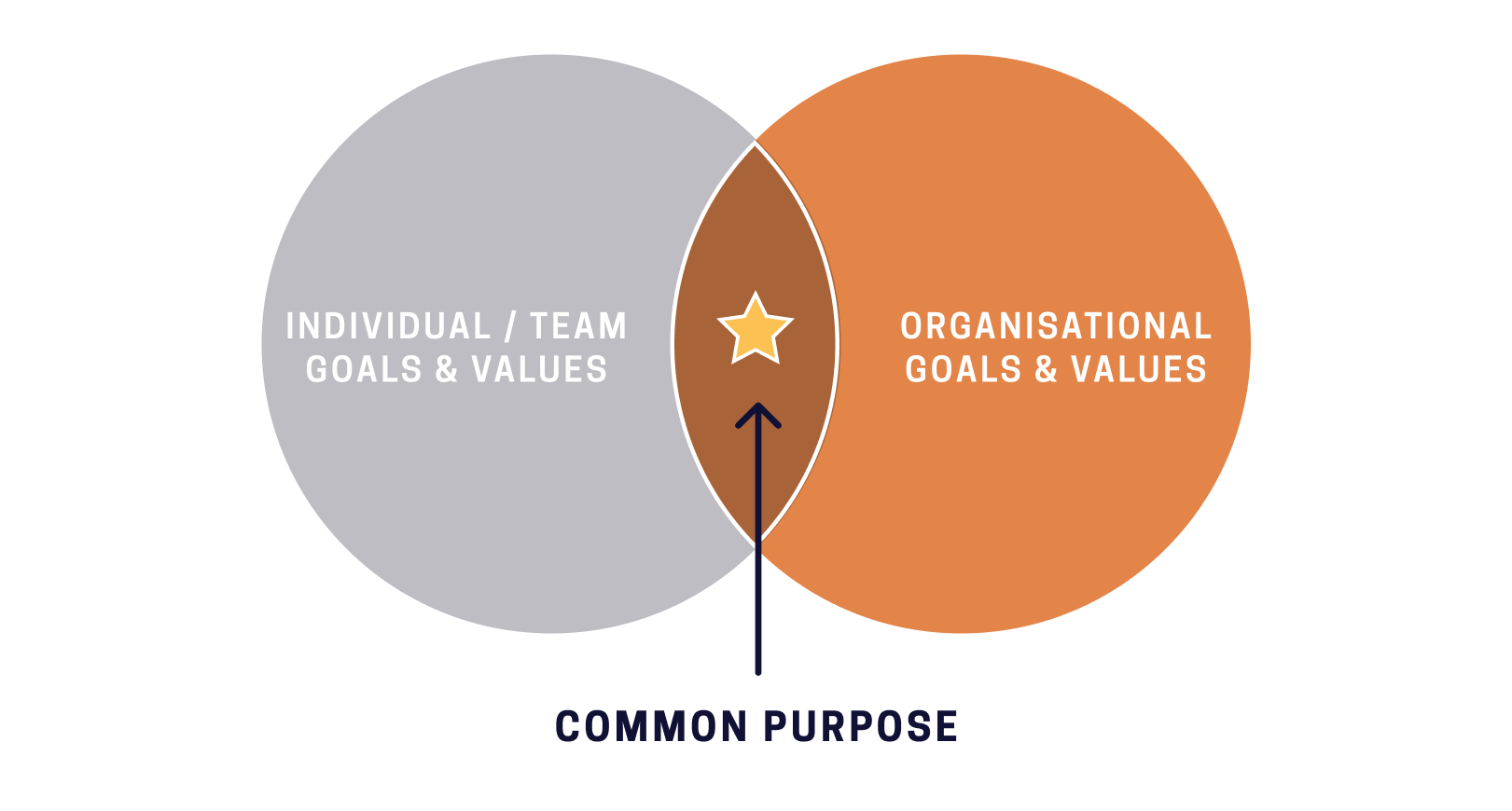As a leader, you may find yourself shifting from leading to reacting to circumstances and urgency. How do you break that trend? It is time to ground your activity in your organization’s Common Purpose.
The age of digital information is precipitating operational change at every level of your organization. Work used to happen in the office; now, work happens anywhere. The applications, systems, and networks have changed. Too often, our tools and processes for decision making, project execution, and measuring success are siloed, unable to adapt to disruption, and narrowly focused on a single outcome. These are contributing to slow project delivery, under-realized outcomes, staff burnout, and turnover. As a result, teams are experiencing missed goals, flat or declining growth, and burdensome capital and operational budgets.
As a leader, you may find yourself shifting from leading to reacting to circumstances and urgency. How do you break that trend? When faced with everything being a priority or urgent need across every business unit and at every level of your organization, how will you decide where to start and what to act on? It is time to ground your activity in your organization’s common purpose.

McChrystal Group defines common purpose as “the way a group of free agents is transformed into a cohesive, orderly team aligned to a shared set of goals and values.”
Beneath all projects, desired outcomes, and stated goals, there is a common purpose that brings together the individual team goals and values with those of the organization. This is always important to effective prioritization but becomes vital as the environment becomes increasingly complex. A common purpose can motivate us beyond what we think possible, and it also provides mechanisms that generate clarity about “the why” and how to achieve your goals.
Here are three actionable steps you can take to leverage your common purpose to prioritize better:
1. Get Perspicuity & Define the Common Purpose
What happens when you don’t have a clear understanding of your organization’s common purpose? You may see a divergent set of priorities and projects, driven by circumstance, begin to consume staff time and finances. A clear aligning narrative supports your resource management and keeps your company on track to achieving strategic goals. If the common purpose is not clear, talk with your team and leadership. Create the space to ask the difficult questions that help you dig deep to really identify and clearly state the one essential need that your company must contend with if it is to continue. Beware, this is bigger than the “elephant in the room,” though that elephant is often the-deep objective amongst all others and becomes the center of the conversation for prioritization.
Leader Tip: An external perspective can be of great value when defining your common purpose. Take the time to have that honest conversation with a trusted advisor, someone who is not part of your organization, and define that one essential need that brings together the team goals and values with the organization’s goals and values. Write it down. Practice and play with how you articulate it, so it feels natural and in your voice. Edit it down until it’s at its very core—less than ten words! This becomes your common purpose when prioritizing.

[At the onset of the pandemic] when prioritizing which needs to fill first and who got their limited product first, we prioritized healthcare because that came back to our purpose and what we were meant to do.”
Linda Rendle
CEO the Clorox Company
2. Garner Participation
Once you have that common purpose defined, share it! Share it with team leaders and ensure it's shared widely across all levels of the organization. Let it begin to resonate at every level of your organization. As you broadly communicate your common purpose and invite different voices to contribute thoughts and ideas, and participate in the process of delivering priorities, you will energize your organization, deepen trust, and break down coalitions and siloes. Give specific focus to creating shared alignment through defining vision, objectives, and actionable strategies; and enforcing it through role modeling, communication, accountability, and key performance indicators. By doing this, leaders can leverage personal behavior and organizational processes to coalesce around the common purpose.
Leader Tip: Make the most of your collaboration and communication technologies, like Microsoft’s Viva Connections and Yammer Communities, to create accessible conversation spaces to communicate your common purpose broadly and invite people at every level to contribute.
3. Gain Perspective
The next step is to help business leaders align their priorities to each of their teams and the common purpose. This will help to provide a holistic and informed positioning of priorities and ultimately help deliver business objectives. For example, McChrystal Group data indicates that leadership teams who articulate which projects take priority had 40% higher company income growth on average one year later than companies whose leaders struggle to articulate.
Leader Tip: Try this practical exercise to gain consensus and grow support for aligning priorities to your common purpose.
Invite your teams to write their top business needs on different color sticky notes. With your Common Purpose at the center of a whiteboard space, have each team take time to place their items, one at a time, on the board, explaining how it contributes to the common purpose. For each new sticky, ask others in the room to contribute to the conversation, identifying ways that it contributes to their team’s productivity or wellbeing. Have each team place a small sticky in their team’s color to remind them of their alignment.
When all your teams have had a chance to place their priorities on a board, you can now begin together to align them in proximity to the common purpose and agree together on the strategy for moving forward.
Not working in the office? Leverage the power of your collaborative meeting technology, like Microsoft Teams meetings. With virtual, collaborative whiteboards and meeting tools like word cloud polls, you can conduct your meeting virtually while still allowing accessible and broad contributions to the conversation.
By clarifying a clear and common purpose, sharing that purpose broadly, inviting participation, and helping teams align with one another, you encourage teams to work together to define and execute on aligned priorities. Solidifying shared consciousness provides those responsible for acting on the tasks that follow a more unified and unilateral basis for acceptance and success.
Visit our Great Prioritization Resources page for more actionable tools and insights.



